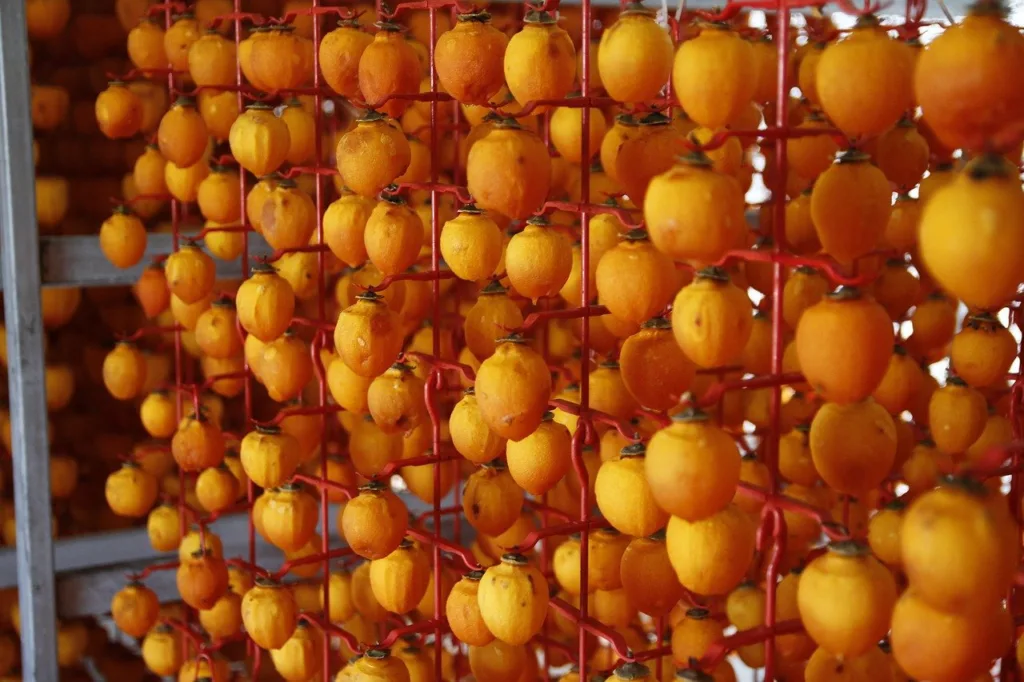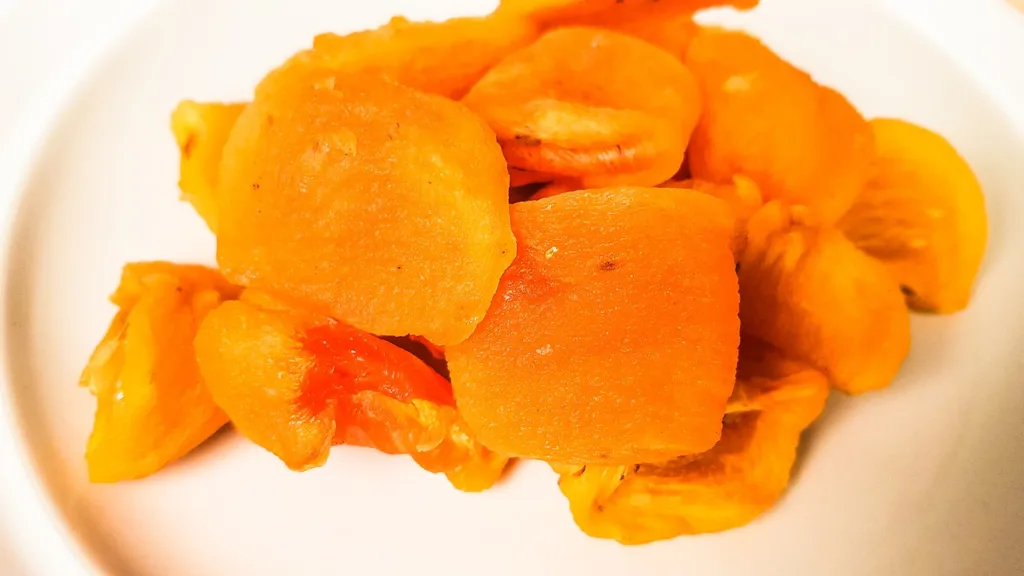Dried persimmon is a fruit that has had most of its moisture removed through a drying process, resulting in preserves, meaning that filled packages can be stored for long periods of time under ambient conditions without refrigeration or freezing snacks.
Persimmons are known for their sweet and rich flavor, and drying them enhances their sweetness as well as creates a chewy and slightly sticky texture.
Dried persimmons are a popular treat in different parts of the world, and they can be enjoyed alone or used as an ingredient in various dishes.
They are a source of natural sugars, dietary fiber, and many vitamins and minerals, making them a relatively healthy and delicious snack option.
Dried persimmon is a traditional dried fruit snack commonly enjoyed in East Asia. It is known by different names in different cultures, such as “shibang” (柿餅) in Chinese, “hoshigaki” (干し柿) in Japanese, “gotgam” (곶감) in Korean and “hong kho” in Vietnamese.
This tasty dish is usually prepared during the winter months when Oriental persimmons are in season. The drying process involves air drying the fruit to retain its natural sweetness and flavor.
The variety of uses for dried persimmons is diverse. Apart from being a standalone snack, they are often used to make wine, added to traditional tea, and incorporated into various desserts.
This custom reflects the rich culinary traditions and appreciation for the persimmon in these cultures.
Production of Dried Persimmon
Dried persimmon production involves several key steps to transform fresh persimmons into a popular dried snack.
Harvesting: The process begins with harvesting ripe persimmons. It is important to select completely ripe fruit with the right color and texture.
Cleaning and Sorting: The harvested persimmons are cleaned to remove dirt and debris. They are then sorted to separate the damaged or unripe fruits from those suitable for drying.
Peeling and slicing: In some cases, persimmons are peeled to remove the skin, while in others, they are left intact. After peeling (if applicable), the persimmons are cut into small, equal pieces.
The size and thickness of the slices can vary depending on the desired final product.
Pre-treatment: To preserve the color and flavor of persimmons, they may need to undergo pre-treatment processes like blanching or dipping in a solution to prevent oxidation.
Drying: The harvested persimmons are then dried using methods such as sun drying, air drying, or mechanical drying. Sun drying is a traditional method where fruits are placed in the sun to dehydrate them naturally.
Mechanical drying, including hot air drying or dehydrator drying, is more controlled and efficient.
Packaging: Once the persimmons reach the desired moisture level, they are packed for distribution. Packaging may involve sealing them in airtight containers or vacuum-sealed bags to preserve freshness.
Quality Control: Throughout the production process, quality control measures are implemented to ensure that dried persimmons meet specific standards for taste, texture, appearance, and safety.

Nutritional Value of Dried Persimmon
| Nutrient | Amount per 100g of Dried Persimmon |
|---|---|
| Calories | Approximately 81-120 calories |
| Carbohydrates | About 19-32 grams |
| Dietary Fiber | Roughly 3-6 grams |
| Sugars | Approximately 13-21 grams |
| Protein | Typically 1-2 grams |
| Fat | Negligible (usually less than 1 gram) |
| Vitamin A | A significant source, often exceeding 50% of the Daily Value (DV) |
| Vitamin C | A moderate source, providing around 10-15% of the DV |
| Potassium | In moderate amounts, typically contributing 6-8% of the DV |
| Calcium | In small amounts, usually offering 2-3% of the DV |
| Iron | In small amounts, providing around 2-3% of the DV |
| Vitamin K | A minor source, contributing less than 1% of the DV |
Dried Persimmon in Korean
In Korean, dried persimmons are known as “곶감” (pronounced “gotgam”). They are a popular and traditional Korean snack, loved for their sweet flavor and chewy texture.
Dried persimmons are commonly eaten in South Korea and are also exported to other countries due to their unique taste and cultural significance.
Dried Persimmon Japanese
In Japanese, dried persimmons are called “干し柿” (pronounced “hoshigaki”). Hoshigaki is a traditional Japanese snack made by air drying persimmons, resulting in a sweet and chewy treat.
These dried persimmons are popular in Japan and are often enjoyed during the autumn season when persimmons are in abundance. They also are a common gift item in Japanese culture.
Different types of Dried Persimmon
- Fuyu Persimmons: These are known for their sweet and non-astringent flavor, making them suitable for drying. They are often peeled, sliced, and air-dried to create dried Fuyu persimmons.
- Hachiya Persimmons: Hachiya persimmons have a more astringent taste when fresh, but when properly ripened and dried, they become sweet and chewy. The drying process helps remove the astringency.
- Giboshi Persimmons: This variety of persimmon is often used for making dried persimmons in Japan. They have a unique flavor and texture when dried.
- American Persimmons: These smaller, more astringent persimmons are sometimes used for drying. The process removes the astringency and enhances their natural sweetness.
- Dongshi Persimmons: A variety of persimmons from Taiwan, known for their sweet and aromatic flavor when dried.
- Jiro Persimmons: Jiro persimmons are another variety with a sweet and non-astringent taste when fresh. They are suitable for drying to create sweet, chewy dried persimmons.

People also ask
Is dried persimmon healthy?
- Yes, dried persimmons can be a healthy snack when consumed in moderation. They retain many nutrients from fresh persimmons, including vitamins A and C, dietary fiber, and natural sugars. However, they are calorie-dense due to their sugar content, so it’s important to enjoy them in reasonable portions.
What is dried persimmons used for?
- Dried persimmons are used as a nutritious and sweet snack. They are also utilized in making wine, added to traditional teas for flavor, and incorporated into various desserts and recipes.
Why is persimmon fruit expensive?
- The cost of persimmon fruit can vary depending on factors like the variety, location, and availability. Some factors contributing to their cost include the labor-intensive process of cultivation, the time it takes for the fruit to ripen, and the handling required to prevent damage.
How many dried persimmons can you eat a day?
- The number of dried persimmons you can eat in a day depends on your dietary needs and overall calorie intake. A small portion, such as 2-4 pieces, can be a reasonable daily serving.
Why do people eat persimmons?
- People enjoy persimmons for their sweet and unique flavor, as well as their nutritional benefits. Persimmons are a good source of vitamins and dietary fiber, making them a popular and healthy choice in various culinary applications.
Dried persimmon how to eat?
- Dried persimmons can be eaten as a standalone snack. You can also use them as a sweet addition to salads, yogurt, or cheese platters. Some enjoy them in baked goods like muffins or cakes or paired with nuts for a wholesome trail mix.
